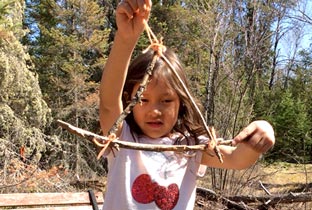Finding Geometric Shapes Outside
Early Years/Primary/Junior (Age 3 – 12)
Curriculum Goal
Kindergarten: Demonstrating Literacy and Mathematics Behaviour
- Compose pictures, designs, shapes, and patterns using 2D shapes, predict and explore reflective symmetry in 2D shapes and decompose 2D shapes into smaller shapes and rearrange the pieces into other shapes using various tools and materials
- Build 3D structures using a variety of materials and identify the 3D figures their structure contains
- Investigate and describe how objects can be collected, grouped and organized according to similarities and differences
- Explore and extend patterns
Context
- Learning about geometric shapes is a normative moment in students’ educational trajectories.
- Often, students identify items that remind them of the common geometric shapes, play with a variety of shapes, and count vertices, edges, and faces.
- While outside, students will explore and find shapes and over several visits will take pictures of shapes and make shapes using sticks.
Materials
- Sticks
- 2D/3D example geometric shapes (if needed to support student learning)
- Shape identification page
- String
- Scissors
- Camera
Lesson
Trip Outside #1
- Start by asking students to name shapes and whether they can think of ways to sort shapes. Encourage students to think of things in their lives that look like different shapes.
- Get students to use their shape identification page to walk through the outdoor classroom (or desired location) and find small items that have a similar shape.
- Ask each group to return to the whole-group with their favourite object they can find. Compare and sort the items as a group.
Trip Outside #2
- Ask students to recall the shapes they identified during the first trip.
- Tell them that this time you want to see whether they can spot shapes in a different way. Encourage your students to notice shapes being created by nature. For example, perhaps three branches intersect to create a triangle.
- Take a photo of their selected shape.
- Now it’s your students’ turn to make shapes with nature. Tell your students they will be making shapes from sticks they find in the outdoor classroom.
- Ask students to choose a shape they think they can make using sticks and ask how many sticks they would require to form that shape. This will help you guide students to an understanding that they will probably only be able to make a triangle or square. The provides opportunity to discuss the differences between the two shapes
- When students have gathered their sticks, position them together and tie with the string.
- When students have completed their shapes, you can put them on display in the outdoor classroom.
- Back in class, print the photos of the nature shapes your students identified. As a class, organize them on the board by sorting them in some manner.

Look Fors
- Are students able to identify different types of 2D and 3D shapes?
- Can students compose and design 3D shapes using 2D shapes and a variety of materials they find in the world around them?
- Can students investigate how objects can be collected, grouped and organized based on their knowledge of shapes?
Share this lesson
Share on facebook
Share on twitter
Share on email
